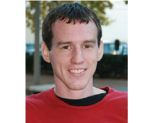Standing Out in the Crowd: Signal-to-Background in Molecular Imaging
James R. Johnson A and David Piwnica-Worms A BA The BRIGHT Institute, Washington University School of Medicine, and Molecular Imaging Center, Mallinckrodt Institute of Radiology, Washington University School of Medicine, and Departments of Cell Biology & Physiology and Developmental Biology, Washington University School of Medicine, St. Louis, MO 63110, USA.
B Corresponding author. Email: piwnica-wormsd@mir.wustl.edu

James R. Johnson is currently a post-doctoral research scholar at the Washington University School of Medicine in Saint Louis, Missouri, USA, under the mentorship of Dr. David Piwnica-Worms. He earned his Ph.D. in 2008 from The University of Notre Dame under the advisory of Dr. Bradley Smith for his thesis ‘Targeted Delivery of Molecular Cargo and Fluorescent Bioimaging Agents’. His current research focuses on synthesis, development and validation of activatable fluorescent probes for in vitro and in vivo optical imaging applications. |

David Piwnica-Worms, M.D., Ph.D., is Professor of Radiology, Cell Biology & Physiology, and Developmental Biology, Director of the BRIGHT Institute and Director of the Molecular Imaging Center at Washington University School of Medicine, St. Louis, Missouri, USA. He earned his bachelor's degree from Stanford University, and graduated from the Duke University Medical Scientist Training Program. He continued his training at the Brigham & Women's Hospital in Diagnostic Radiology and began his first faculty appointments at Harvard Medical School. After rising to Associate Professor, Dr. Piwnica-Worms was recruited to Washington University School of Medicine and the Mallinckrodt Institute of Radiology. Dr. Piwnica-Worms has been a pioneer of the field of molecular imaging. His research interests encompass applications of molecular cell biology, high throughput screens, and chemistry to molecular imaging in vivo with specific focus on development of genetically-encoded reporter systems for imaging gene expression in vivo, imaging signal transduction and protein-protein interactions in whole cells and animal models, and biochemical analysis of the function and regulation of the multidrug resistance P-glycoprotein family of transporters. He also pursues translational research directed toward imaging in vivo using activatable optical probes, as well as technetium-99m and gallium-68 labeled radiopharmaceuticals in nuclear medicine applications. He is a founding member and former president of the Society for Molecular Imaging, and recipient of the Society for Molecular Imaging Lifetime Achievement Award as well as the Distinguished Alumnus Award, Duke University Medical School. |
Australian Journal of Chemistry 64(5) 590-592 https://doi.org/10.1071/CH11126
Published: 30 May 2011
References
[1] S. Gross, D. Piwnica-Worms, Cancer Cell 2005, 1, 5.[2] M. A. Whitney, J. L. Crisp, L. T. Nguyen, B. Friedman, L. A. Gross, P. Steinbach, R. Y. Tsien, Q. T. Nguyen, Nature Biotech. 2011, in press. 10.1038/NBT.1764
[3] D. Bailey, D. Townsend, P. Valk, M. Maisey, Positron Emission Tomography: Principles and Practice 2003, p. 884 (Springer-Verlag: London).
[4] R. Singer, D. Lawrence, B. Ovryn, J. Condeelis, J. Biomed. Opt. 2005, 10, 051406.
| Crossref | GoogleScholarGoogle Scholar | 16292943PubMed |
[5] V. Villalobos, S. Naik, D. Piwnica-Worms, Annu. Rev. Biomed. Eng. 2007, 9, 321.
| Crossref | GoogleScholarGoogle Scholar | 1:CAS:528:DC%2BD2sXhtVehtLbE&md5=e68424e10883e15f3bfdcebbcd58878bCAS | 17461729PubMed |
[6] R. Weissleder, M. J. Pittet, Nature 2008, 452, 580.
| Crossref | GoogleScholarGoogle Scholar | 1:CAS:528:DC%2BD1cXktFCgt7Y%3D&md5=996e84a3e5de282fdb5e6573f0c1bec4CAS | 18385732PubMed |
[7] R. Dothager, K. Flentie, B. Moss, M. Pan, A. Kesarwala, D. Piwnica-Worms, Curr. Opin. Biotechnol. 2009, 20, 45.
| Crossref | GoogleScholarGoogle Scholar | 1:CAS:528:DC%2BD1MXlslWgsrg%3D&md5=4cafefaec988832648f25913584a1cbeCAS | 19233638PubMed |
[8] M. Monk, C. Holding, Oncogene 2001, 20, 8085.
| Crossref | GoogleScholarGoogle Scholar | 1:CAS:528:DC%2BD3MXptlKktb8%3D&md5=8fa83d90f834e5d39baf11be5de9655cCAS | 11781821PubMed |
[9] M. Bissell, D. Radisky, Nat. Rev. Cancer 2001, 1, 46.
| Crossref | GoogleScholarGoogle Scholar | 1:STN:280:DC%2BD387mvVOhtw%3D%3D&md5=3506d83d9793ed5608469d5a4d5a4355CAS | 11900251PubMed |
[10] J. Condeelis, R. Weissleder, Cold Spring Harb. Perspect. Biol. 2010, 2, a003848.
| Crossref | GoogleScholarGoogle Scholar | 1:CAS:528:DC%2BC3MXhsFKqtLg%3D&md5=b8cf308fc642edb588bf05f636d4ae7fCAS | 20861158PubMed |


